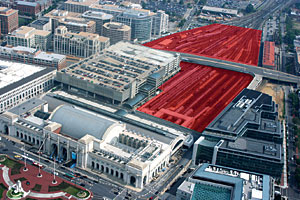The end state of this project will be seriously constrained by its failure to “capitalize” on the spatial possibilities opened up by its strong relationship to transportation and its rare anything-possible beginning state. And although all the actors involved diligently tithe the idea of a mixed-use, green, and design-intensive neighborhood, they all claim to be powerless to achieve anything beyond the alleged market constraints and planning default. Nevertheless, the D.C. planning department—which now has unusually enlightened leadership—continues to struggle to retrofit the unbuilt project with decent streetscapes and a set of secondary uses beyond mere retail. Stay tuned.


The irony of the accidental plaza suppressed in New York and the impossibility of producing any plaza, legible center, or sense of hierarchy and variety in Washington lies in the fact that while the founding physical conditions are opposites, the conceptual cage in which both sets of circumstances are locked is identical. Most of us can recognize decent urbanity when we see it, but we are constrained by the inefficiencies and limits of paradigms that are too narrow, too limited, too unimaginative.
Whether it’s the treacly reproduction of historic forms devolved from any meaningful context, the brutalizing celebration of capital’s “creative” destruction as unassailable spirit guide, the slavish futures of current fashion, or the devil-made-me-do-it obedience to the “as-of-right” city, the results too consistently fail to satisfy the basic tenets of good city life.
Relying on the collective
Like many others, I am both wonderfully impressed by the energy of the new Obama administration and increasingly skeptical of the flow of stimulus funds to the big banks and corporations whose ineptitude and greed got us into this mess. After years of seething at the Republican and “new” Democrat mantra of government incompetence and irrelevance, it is stunning to see how quickly the fat cats and indifferent libertarians have turned to the collectivity to pull the singed chestnuts of flaming capital out of the fire. And yet, the application of stimulus structurally repeats the old Republican fantasy of wealth’s distribution: By making life agreeable for the rich, benefit will trickle down to those less empowered.
Our cities need a stimulus package that works from the bottom up and—from us—a mighty stimulus package for the imagination. At NoMa, it is only the disenfranchised government, left without powerful enough administrative tools, without funds, and with influence too diminished, that can and should act to secure the genuinely highest and best use of the site. While build-out (when it eventually occurs) will certainly result in a greatly enhanced revenue stream, and while many argue that this money should return to the site in the form of improvements, this is both too late and contravenes the larger fiduciary obligations of the public sector, which must always balance the competing claims of the citizenry as a whole. The tax-increment-financing model, and the Business Improvement District overlay, masquerade as a kind of community empowerment but actually function to sustain the disproportionate enabling of the already empowered.
While I have deep skepticism about top-down approaches to planning and the too-frequent privileging of the formal over the social in dealing with questions of the city, there are many occasions in which government must decisively step in and set the agenda, the standard, and the solution. To invariably associate such intervention with the dystopian stylings of Robert Moses, Albert Speer, or Walt Disney, is to be stupid about the real obligations and possibilities of the collectivity. How tired I am of hearing endlessly about the so-called “public-private” model (as if there were any other in a democracy) when all it amounts to is a cover for the public’s giving away the store, acting on the same grasping profit model as those corporations whose only idea of public interest is sucker rates on adjustable mortgages and credit cards.
Now that the government has moved so swiftly and insistently to plan the economy, has embraced its role in providing medical care for all, is ponying up untold billions to save Afghanistan, perhaps the same kind of bold responsibility might be taken for the mess at home. Bailing out General Motors is not exactly transit-oriented development.





Post a comment to this article
Report Abusive Comment